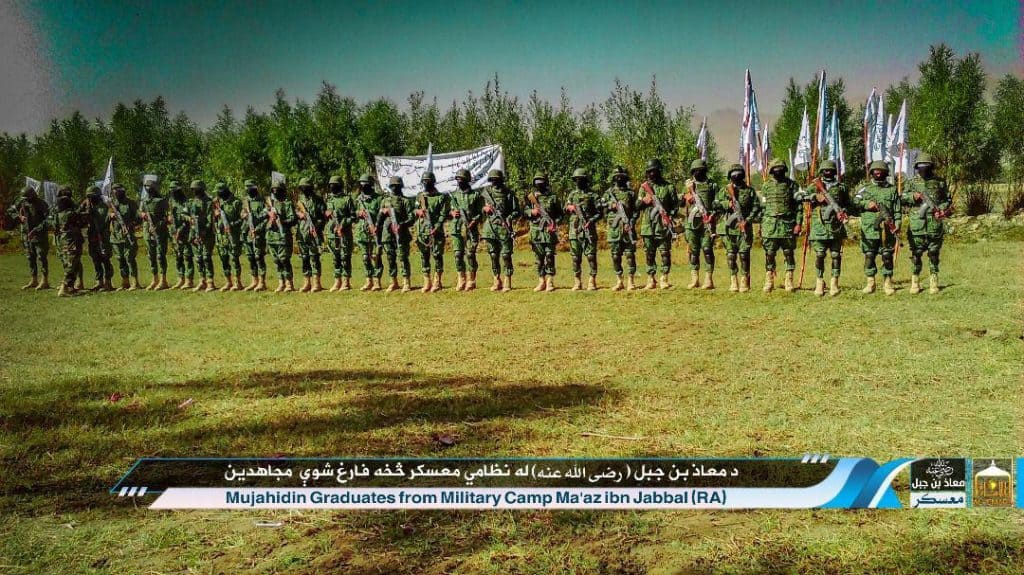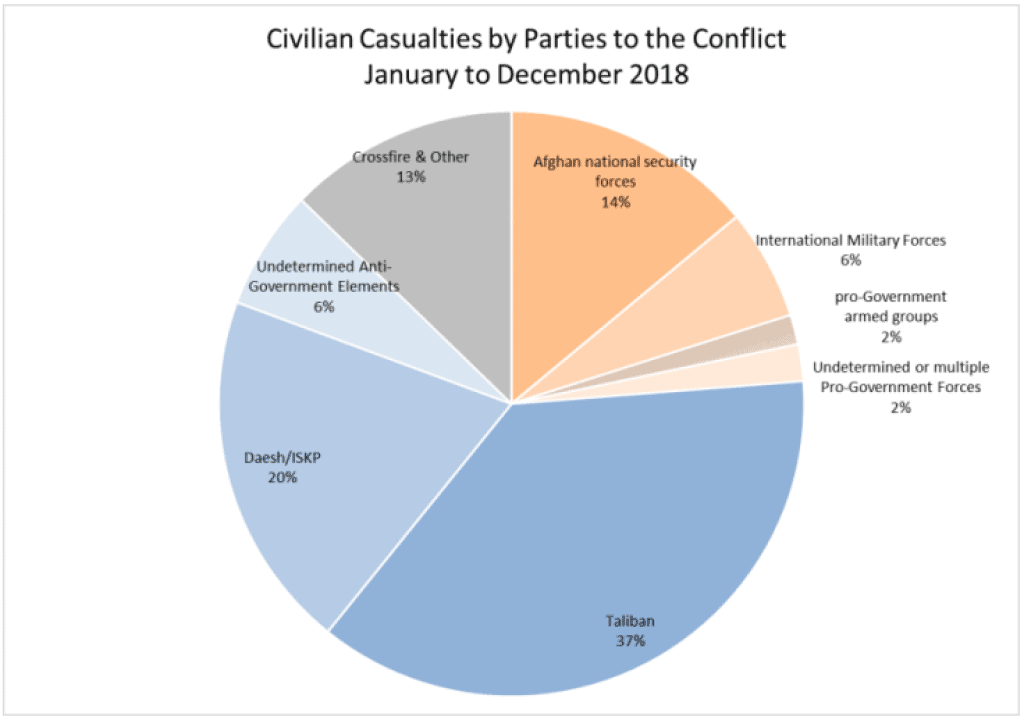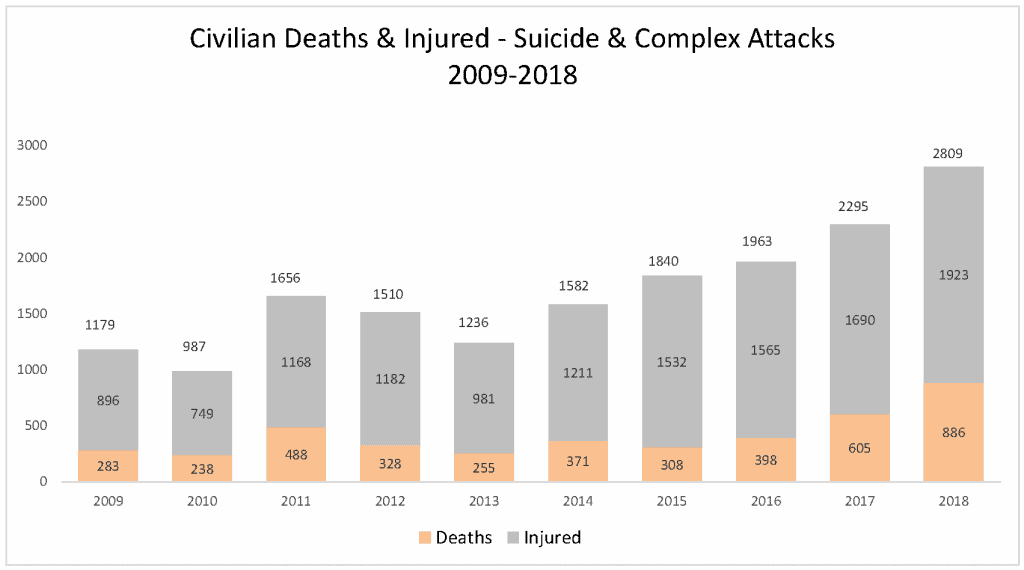BY THOMAS JOSCELYN
 More civilians were killed in Afghanistan in 2018 than in any of the previous nine years, according to a newly released report by the United Nations Assistance Mission in Afghanistan (UNAMA). The majority of these deaths were caused by operations carried out by the Taliban and the Islamic State’s so-called Khorasan province. And even though the Taliban is nominally concerned with how its violence is perceived, the group has been responsible for more civilian casualties than any other party in the conflict.
More civilians were killed in Afghanistan in 2018 than in any of the previous nine years, according to a newly released report by the United Nations Assistance Mission in Afghanistan (UNAMA). The majority of these deaths were caused by operations carried out by the Taliban and the Islamic State’s so-called Khorasan province. And even though the Taliban is nominally concerned with how its violence is perceived, the group has been responsible for more civilian casualties than any other party in the conflict.
In its annual report for 2018, UNAMA says it documented 10,993 civilian deaths and injuries. Although this total casualty figure was eclipsed in two previous years, it remains close to the historical peak. In addition, the number of civilians killed (3,804 men, women and children) is greater than in any year since 2009, when UNAMA first began tracking casualties in the conflict.
“Anti-Government Elements” — namely, the Taliban and the Islamic State’s arm (referred to as “Daesh/ISKP” in the report) — were responsible for “6,980 civilian casualties (2,243 deaths and 4,737 injured).” That is approximately 63 per cent of the total.
UNAMA says this slight uptick in total casualties, as compared to 2017, “came mainly from the indiscriminate use of suicide and other IED tactics in civilian areas and the deliberate targeting of civilians with these devices, mainly by Daesh/ISKP, as well as the use of indirect fire systems such as mortars, grenades and rockets in and from civilian-populated areas during ground engagements.”
While Abu Bakr al-Baghdadi’s loyalists are prolific killers, the Taliban is still the prime culprit when it comes to civilian casualties — a finding that is consistent with past UNAMA reports. UNAMA produced this pie chart showing that the Taliban was responsible for more civilian casualties than any other party. The Islamic State’s arm (“Daesh/ISKP”) also caused far more harm to civilians in 2018 than in 2017.
UNAMA produced this pie chart showing that the Taliban was responsible for more civilian casualties than any other party. The Islamic State’s arm (“Daesh/ISKP”) also caused far more harm to civilians in 2018 than in 2017.
 UNAMA produced this pie chart showing that the Taliban was responsible for more civilian casualties than any other party. The Islamic State’s arm (“Daesh/ISKP”) also caused far more harm to civilians in 2018 than in 2017.
UNAMA produced this pie chart showing that the Taliban was responsible for more civilian casualties than any other party. The Islamic State’s arm (“Daesh/ISKP”) also caused far more harm to civilians in 2018 than in 2017.
UNAMA “attributed 4,072 civilian casualties (1,348 deaths and 2,724 injured)” to the Taliban. This is “37 per cent of all civilian casualties,” and significantly more than those caused by the Islamic State.
Yet, the self-declared caliphate’s representatives killed or wounded more people in Afghanistan in 2018 than in previous years.
UNAMA attributes “2,181 civilian casualties (681 deaths and 1,500 injured)” to the Islamic State, a substantial “increase of 118 per cent compared to 2017.” In all, the Islamic State’s men were responsible for “20 per cent of all civilian casualties” in Afghanistan last year.
Nearly 60% of the civilians killed (2,243 people) perished in attacks conducted by the Taliban, or the Islamic State’s arm. The Taliban was responsible 1,348 of these deaths, as compared to the 681 deaths caused by the Islamic State. That is, the Taliban caused nearly twice as many civilian casualties as Baghdadi’s men.
Taliban attacked parliamentary elections, including schools used as polling places
The Taliban repeatedly threatened to target voting sites used in parliamentary elections last October. Several commissions within the Taliban’s shadow government warned the public to stay away from the voting locales. The organization’s leadership called for attacks on the sites, saying the elections were un-Islamic. [See FDD’s Long War Journal reports: Taliban calls for attacks to disrupt Afghan elections and It’s a ‘religious duty’ to oppose Afghan elections, Taliban says.]
The Taliban followed through on its threats, targeting schools and other public voting locations. Attacks by both the Taliban and the Islamic State “against voter registration sites resulted in hundreds of civilian casualties and impacted the right to education for children who were unable or too afraid to attend classes for long periods due to insecurity.”
“While many citizens were able to cast their vote, many others faced threats, intimidation, abductions and violence, mainly from Taliban who attempted to prevent participation in the elections,” UNAMA reports. In fact, the “first day of polling was marked by the highest number of civilian casualties (mainly injuries) recorded on any single day in 2018, which contributed significantly to the civilian casualties from indirect fire systems over the year.”
UNAMA “recorded 191 incidents affecting education, including attacks targeting or incidentally damaging schools; the killing, injury and abduction of education personnel; and threats against education facilities and personnel.” This figure is “almost three times the number of incidents documented in 2017.”
While many of these “incidents” were related to the Taliban’s anti-election campaign of violence, the group also deliberately targeted schools for other reasons.
The Taliban threatened or took action against schools in the provinces of Badghis, Badakhshan, Farah, Ghazni, Herat, Kunduz, Logar and Takhar. When the Afghan Department of Education decided to pay teachers’ salaries via bank transfers, as opposed to in cash, the Taliban “issued a directive ordering the closure of 342 schools throughout Kunduz province.” The transfers made it more difficult for the Taliban to collect taxes on teachers’ salaries and, therefore, the jihadists moved against the schools as a punitive measure. The same situation occurred in Ghazni province, where the Taliban “abducted 125 education personnel, including school teachers, principals and district education officials…because they were receiving their salaries via bank accounts.”
In other cases, the Taliban attacked schools for ideological reasons. For instance, UNAMA says that on at least five occasions the Taliban targeted “mixed or girls’ high schools” in Farah and Herat. The jihadists burned some schools and detonated improvised explosive devices (IEDs) in others. The Taliban also “shot and killed the headmaster of a girls’ high school in Herat province.”
In Logar province, the Taliban “gathered girls’ school principals and ordered that female teachers of grades one to 12 and girls studying in grades seven to 12 should no longer attend school.” The “threats led to the suspension of classes for girls above grade six in the district and the replacement of female teachers for younger girls with male teachers,” according to UNAMA.
The Islamic State is also orchestrating a “deliberate campaign” against schools, “particularly girls’ schools,” which has “had a severe impact on education.”
Islamic State’s Khorasan “province” operates primarily in eastern Afghanistan
According to UNAMA’s data, the “vast majority” of “incidents” attributed to the Islamic State’s men occurred in the eastern province of Nangarhar, where the caliphate’s men have long had a presence. UNAMA counts 138 total incidents involving the Islamic State, and 102 of these (nearly three-fourths of the total) were located in Nangarhar. Another 20 took place in the capital of Kabul.
The number of civilian casualties attributed to the Islamic State’s arm more than doubled in 2018, as compared to 2017. UNAMA says this “significant increase… was mainly due to the increase in suicide and complex attacks, nearly all of which were carried out against civilians or in civilian populated areas.” Indeed, “[s]uicide and complex attacks accounted for 87 per cent of all civilian casualties attributed to Daesh/ISKP in 2018.” “Suicide & Complex Attacks” have become a “leading cause” of civilian casualties, second only to ground engagements. The number of casualties due to such attacks has steadily increased since 2014, as the Islamic State has prioritized suicide bombings against civilians.
“Suicide & Complex Attacks” have become a “leading cause” of civilian casualties, second only to ground engagements. The number of casualties due to such attacks has steadily increased since 2014, as the Islamic State has prioritized suicide bombings against civilians.
 “Suicide & Complex Attacks” have become a “leading cause” of civilian casualties, second only to ground engagements. The number of casualties due to such attacks has steadily increased since 2014, as the Islamic State has prioritized suicide bombings against civilians.
“Suicide & Complex Attacks” have become a “leading cause” of civilian casualties, second only to ground engagements. The number of casualties due to such attacks has steadily increased since 2014, as the Islamic State has prioritized suicide bombings against civilians.
Both the Taliban and the Islamic State carry out “suicide and complex” attacks, but the so-called caliphate has made these types of operations a priority. UNAMA says that 21 “suicide and complex” attacks were attributed to the Taliban in 2018, while another 36 were conducted by the Islamic State.
Such attacks have become a “leading cause” of civilian casualties in Afghanistan, second only to ground engagements, and have repeatedly rocked Kabul.
The Taliban’s suicide and complex operations caused “642 civilian casualties (216 deaths and 426 injured),” while the Islamic State’s attacks caused “1,892 civilian casualties (557 deaths and 1335 injured).” That is, the Islamic State’s suicide and complex attacks were nearly three times as damaging, in terms of casualties, as the Taliban’s.
Increase in casualties due to aerial operations conducted by Afghan government and international military forces
While the jihadists kill and injure more civilians than any other parties, UNAMA also documented an increase in the number of casualties attributed to “Pro-Government Forces,” which caused nearly one-quarter of the total.
UNAMA says “2,612 civilian casualties (1,185 deaths and 1,427 injured)” were caused by the Afghan government and its international allies, “a 24 per cent increase in civilian casualties as compared to 2017.”
This “increase was mainly driven by a “significant increase in civilian casualties resulting from aerial operations by international military forces as well as from search operations conducted by Afghan national security forces and pro-Government armed groups.”
Thomas Joscelyn is a Senior Fellow at the Foundation for Defense of Democracies and the Senior Editor for FDD's Long War Journal.
Are you a dedicated reader of FDD's Long War Journal? Has our research benefitted you or your team over the years? Support our independent reporting and analysis today by considering a one-time or monthly donation. Thanks for reading! You can make a tax-deductible donation here.
No comments:
Post a Comment